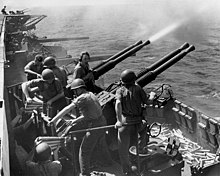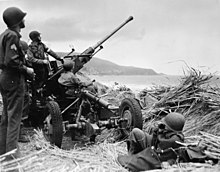40 mm Bofors gun

Developed by the Swedish armaments manufacturer Bofors , the 40 mm Bofors gun from the 1920s is still used by many armies today. Its high rate of fire and high muzzle velocity made it an effective multi-purpose weapon. This gun was also available as a double mount (MDL - Marinedoppellafette) in various designs. It was also used on ships for anti-aircraft and anti-ship missions.
The weapon system in the German army was replaced by the more modern anti-aircraft missile system Roland .
After that it was still in use by the German Navy , also for anti-aircraft defense at naval aviation stations MFG 1 in Jagel , MFG 2 in Tarp-Eggebek and MFG 3 in Nordholz . Here the cannon was equipped with a multiple loading device with 154 rounds. The weapon had a 2.80 m long tube ( caliber length 70) and could be aimed manually via the NIFE reflex sight , but mainly via the Fledermaus D7B fire control device .
Development history
1922 bought Swedish navy some pom-poms by Vickers as anti-aircraft guns . Ultimately, however, the Navy was dissatisfied with the guns and turned to Bofors with a request to develop a more powerful replacement.
Bofors was hesitant at first because the Swedish Navy was a very small customer market. But when the Navy agreed to pay for the development of a prototype , the development contract was signed at the end of 1928. Bofors responded with a weapon that was in some ways a smaller version of the 57mm cannon developed by Finspong in 1922 to defend against torpedo boats . The first test sample was actually a Nordenfelt version of the Finspong cannon, which was fitted with a customized barrel and a semi-automatic loading mechanism.
Tests of this weapon in 1929 showed that the ammunition supply was the main problem. A mechanism strong enough to handle the large cartridge was also too heavy to achieve a high rate of fire. An interesting approach to solve this problem, questioned the use of cartridge cases from zinc , which fall burned during firing. However, this process produced heavy zinc deposits in the pipes and had to be abandoned. In the summer of 1930, experiments began with a new test weapon that dispensed with the controlled ammunition feed and ejected the empty cases backwards. At the same time, a second mechanism inserted a fresh cartridge from the magazine into the open breech. This appeared to be a viable solution, as it gave an acceptable rate of fire. Work on the prototype began shortly afterwards.
At the same time, Krupp acquired a third of Bofors. The new partner's engineers began converting Bofors' factories to modern equipment and metallurgy . The project of the 40 mm cannon was kept secret. Even so, many sources claim that the 40mm development was actually derived from a croup development. The only German weapon with a similar caliber and purpose, however, was the 3.7 cm SK C / 30 manufactured by Rheinmetall . However, these two weapons are so different from each other that there is no evidence to support this assumption.
In early November 1931, the prototype was completed and fired for the first time, and by the middle of the month bursts of two and three rounds could be fired. So only remained improvements to the ammunition supply left, and the end of the year was a cadence achieved of 130 rounds per minute. Further development steps were necessary to make the weapon ready for production, and this goal was achieved in October 1933. Since the acceptance tests had already been completed the previous year, the weapon became known as the 40 mm akan M / 32 . Most of the armed forces referred to them as Bofors 40mm L / 60 , although the barrel length was actually only 56.25 caliber lengths and not 60 as the name suggests.
Now that the development was successfully completed, the Swedish Navy wanted a lighter, manually operated weapon in the caliber range from 13 to 25 millimeters and began testing different models from foreign manufacturers. Based on the advanced development of the 40 mm cannon, Bofors offered a variant in caliber 25 millimeters in 1932, which was introduced under the name 25 mm akan M / 32 .
The first version of the 40 mm model ordered by the Navy was intended for use on submarines . The barrel was shortened to 1.68 meters (caliber length 42), which reduced the muzzle velocity to 700 m / s . When the weapon was not in use, it could be lowered into a watertight cylinder with the barrel erect.
The first order for a "real" L / 60 came from the Dutch Navy , which in August 1934 ordered five twin mounts for the cruiser De Ruyter . These guns were mounted on the so-called Hazemeyer carriage . This is an assembly stabilized in three axes, which - at least in theory - could completely decouple the weapon from the ship's movements. However, she weighed 7,000 kilograms. All five gun positions were controlled by a single fire control system.

Bofors also began developing a suitable wheel carriage for use on land, which was first presented in April 1935 at a trade fair in Belgium . This four-wheel mount caused a sensation, as the gun could be fired directly without showing off , even if part of the accuracy fell by the wayside . If time was available for an orderly setup, the crew could use the tow bar and the barrel lock as a lever to lift the wheels off the ground and thereby lower the gun onto support plates. Two additional support legs were folded out to the side and the gun was aligned with hand cranks. The entire setup could be completed by experienced teams in less than a minute.
Orders for the land-based version began immediately after this presentation, starting with Belgium in August 1935 with eight guns. This was followed by a spate of orders from other armed forces, including those from Poland , Norway and Finland. The weapon was only adopted by the Swedish army in the following year under the designation 40 mm Ivakan m / 36 , whereby the lowercase "m" indicates an army model - in contrast to the naval model with a capitalized "M".

Since the 1970s, the cannon has also been used on various versions of American gunships . The Lockheed AC-130 is an example here . In some series this uses two 40 mm Bofors guns to combat ground targets. The Gatling cannons and the Bofors guns in newer versions of the gunship were to be replaced by 30 mm automatic cannons . However, this project was discontinued for various reasons and the combination of Gatling and Bofors is still used.
Technical specifications
40mm L / 60
- Caliber: 40 millimeters
- Grenade: 40 × 311R
- Bullet weight: 900 grams
- Weight: 1981 kilograms
- Muzzle velocity: 810 m / s
- Rate of fire: 120 rounds per minute
- Firing range: maximum 7160 meters, 9830 meters at 45 ° shooting angle
- Depending on the type of ammunition, self-destruction after 2700 to 3200 meters
40mm L / 70
- Caliber: 40 millimeters
- Grenade: 40 × 364R
- Bullet weight: 870 grams
- Weight: 5150 kg
- Muzzle velocity: 1030 m / s
- Rate of fire: 240 rounds per minute, later versions up to 330 rounds per minute
- Firing range: maximum 12,500 meters
User countries

-
 Abu Dhabi
Abu Dhabi
-
 Algeria
Algeria
-
 Egypt
Egypt
-
 Argentina
Argentina
-
 Australia
Australia
-
 Bangladesh
Bangladesh
-
 Belgium
Belgium
-
 Belize
Belize
-
 Brazil
Brazil
-
 Brunei
Brunei
-
 Chile
Chile
-
 Denmark
Denmark
-
 Germany
Germany
-
 Dubai
Dubai
-
 Ecuador
Ecuador
-
 Finland
Finland
-
 France
France
-
 Greece
Greece
-
 Guatemala
Guatemala
-
 Yemen
Yemen
-
 India
India
-
 Indonesia
Indonesia
-
 Ireland
Ireland
-
 Iraq
Iraq
-
 Iceland
Iceland
-
 Israel
Israel
-
 Italy
Italy
-
 Japan
Japan
-
 Jordan
Jordan
-
 Canada
Canada
-
 Cambodia
Cambodia
-
 Qatar
Qatar
-
 Croatia
Croatia
-
 Latvia
Latvia
-
 Libya
Libya
-
 Lithuania
Lithuania
-
 Malaysia
Malaysia
-
 Malta
Malta
-
 Mexico
Mexico
-
 Myanmar
Myanmar
-
 Netherlands
Netherlands
-
 Norway
Norway
-
 New Zealand
New Zealand
-
 Oman
Oman
-
 Austria
Austria
-
 Pakistan
Pakistan
-
 Panama
Panama
-
 Peru
Peru
-
 Philippines
Philippines
-
 Poland
Poland
-
 Portugal
Portugal
-
 Saudi Arabia
Saudi Arabia
-
 Serbia
Serbia
-
 Singapore
Singapore
-
 South Africa
South Africa
-
 South Korea
South Korea
-
 Spain
Spain
-
 Sri Lanka
Sri Lanka
-
 Sweden
Sweden
-
 Switzerland
Switzerland
-
 South Vietnam
South Vietnam
-
 Taiwan
Taiwan
-
 Thailand
Thailand
-
 Uruguay
Uruguay
-
 Turkey
Turkey
-
 Hungary
Hungary
-
 United Arab Emirates
United Arab Emirates
-
 United Kingdom
United Kingdom
-
 United States
United States
-
 Venezuela
Venezuela
-
 Cyprus
Cyprus
Web links
- Bofors 40 mm L / 60 Model 1936 on navweaps.com (English)
- Short Range AA Gun Systems of the Royal Navy on quarryhs.co.uk (English)
- Bofors Flak 40 mm L / 70 on hawkies.de
- Bofors 40mm on YouTube - Part 1 - German
- Bofors 40mm on YouTube - Part 2 - German
- Bofors 40mm on YouTube - Part 3 - German
Individual evidence
- ↑ Terry Gander: The Bofors Gun. Pen & Sword Military, 2013, p. 99 ff.
- ↑ A Spookier Spooky, 30mm at a Time? Nope. In: defenseindustrydaily.com. Defense Industry Daily, March 1, 2012, accessed October 11, 2013 .
- ↑ Bofors 40 mm L / 60 Model 1936. In: navweaps.com. NavWeaps, August 8, 2018, accessed August 8, 2019 .




